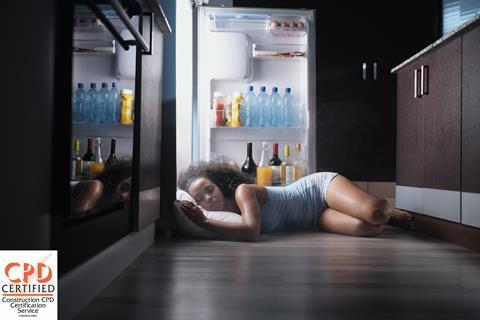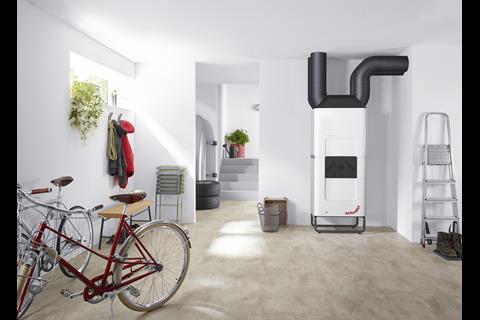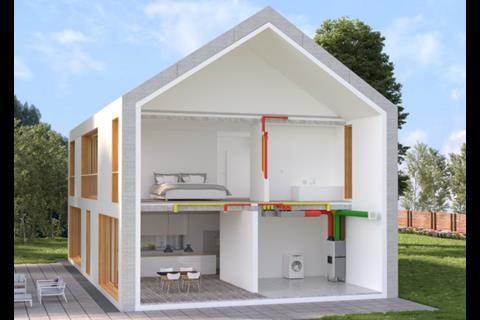
This module ŌĆō sponsored by indoor climate specialists Zehnder Group UK ŌĆō will explore the factors that contribute to overheating in residential projects alongside the relevant regulations and ventilation solutions that can help combat rising temperatures

According to its fixed-temperature test, the Chartered Institute of ║├╔½Ž╚╔·TV Services Engineers (CIBSE) defines residential overheating as ŌĆ£when the internal temperature threshold of 26┬║C is surpassed for over 3% of the timeŌĆØ. Exceeding this temperature threshold for extended periods can affect occupant thermal comfort, health and wellbeing, and productivity.
As ║├╔½Ž╚╔·TV Regulations require improved energy-efficiency and indoor air quality standards for residential ventilation systems, properties are becoming more thermally efficient and airtight. This, among other factors, has led to an increase in the number of properties at risk of overheating.
Learning objectives:
- Awareness of the impact of and factors that contribute to overheating in residential properties
- Knowledge of the regulations surrounding overheating, which are subject to future changes
- Ability to specify ventilation solutions that can combat overheating in residential projects
- Understanding of the importance of thermal modelling to prevent homes exceeding 26┬║C
Thermal comfort ŌĆō ŌĆ£that condition of mind which expresses satisfaction with the thermal environmentŌĆØ ŌĆō is subjective and can be determined by various factors, including age, sex and health conditions.
Another critical factor is the timing and duration of high temperatures. A short increase in temperature during the day when the home is unoccupied has a lesser impact than a prolonged excessive temperature at night when occupants are trying to sleep.
High temperatures in homes negatively impact human life. Overheating can lead to heat stress or impaired sleep. More severe effects include heat stroke, cardiovascular strain or trauma and, in some cases, premature death. CIBSE has advised that if the issue is not addressed, 4,500 premature deaths annually are expected by 2050.
Those most at risk are infants who cannot regulate their temperature, elderly occupants who may be unable to move or remove clothing if they become hot, and those with health conditions who are less physically able to acclimatise or adapt to keep cool. In addition, those living in urban areas are also at risk due to the urban heat island effect, which will be discussed later in this module.
Changing climate
Climate change has led to increasing summer temperatures, and the Met OfficeŌĆÖs future climate projections, under a high emissions scenario, suggest the temperature of hot summer days could rise again by between 3.8┬║C and 6.8┬║C in coming decades.
Our recent summers have already been characterised by extremes in the UKŌĆÖs climate. The summer of 2018 saw temperatures far above the long-term average in the Northern Hemisphere, with four heat waves resulting in 1,067 excess deaths. In the summer of 2022, temperature records soared beyond 40┬║C for the first time, and large parts of the country experienced unprecedented discomfort due to overheating. Many had to flee their homes in search of cooler and safer dwellings.
In a study led by Loughborough University, in partnership with BRE, summertime overheating in 750 English homes was assessed through both monitoring and questionnaires. When the results were weighted to the national housing stock, the study revealed that 4.6 million English bedrooms (19%) and 3.6 million living rooms (15%) were overheated.
The other key findings from the study were:
- Overheating was more prevalent in bedrooms at night than in living rooms during the day.
- The prevalence of living room overheating was significantly greater in flats (30%) than in other dwelling types.
- Improved fabric energy efficiency did not significantly increase the risk of overheating.
- The prevalence of monitored overheating was greater in households living in social housing, with low incomes or with members aged over state pension age.
Heatwaves will increase in frequency, making this a modern-day issue that is here to stay. This means that the use of air-conditioners is set to soar further, placing more pressure on global electricity demand.
Conditioning air
Traditional methods of combating overheating often rely on air-conditioning units. Roughly two billion air-conditioning units are now operating worldwide, with 70% of the units in residential properties. This approach can have negative effects on indoor air quality. By merely recirculating air, these systems can reintroduce potentially harmful particulates such as dust and allergens, compromising occupantsŌĆÖ health.
These systems use considerable energy and present a concern amid the escalating energy crisis. They also run on refrigerant gases that impact the planetŌĆÖs ozone layer, with the cooling industry accounting for 10% of all global CO2 emissions.
Air-conditioning units are expensive to run and add another service to the standard workings within the building, which must be maintained. They also tend to sit dormant through the winter months when the temperatures fall again.
Adopting a ventilation-first approach provides a solution to overheating issues and protects indoor air quality within the home. But before we explore the various solutions that offer benefits far greater than traditional air-conditioning units, we must first examine the factors causing our homes to overheat.
Causes of overheating
The most apparent factors resulting in overheating are the weather and the season. Houses overheat predominantly in the summer, and the hotter and longer summers expected due to changing climate conditions will only add to the problem. However, there are other factors at play.
Urbanisation is causing people to live in more dense populations. This often means that acoustic and air quality concerns lead developers to specify unopenable windows, or occupants choose not to open them at night due to noise levels or security concerns.
Often, properties are built with excessive glazing, with aesthetic requirements leading to the specification of floor-to-ceiling windows. This excess glazing adds no real benefit in terms of daylighting but does increase solar gain and the risk of overheating during the summer months.
The output of appliances is a factor often taken for granted. Fridges, televisions, boilers, cookers and lighting all emit heat. Although heat levels will be low, they could put the property at risk, especially if it is airtight. People also give off heat, so if the property is overpopulated, this can lead to issues.
Poor building design will have a detrimental effect on a homeŌĆÖs temperature. ║├╔½Ž╚╔·TV orientation relative to glazing, airtightness and insulation should be considered. Houses are often designed with regulations in mind using SAP as a design tool. This approach means elements of the house can tend to be considered in isolation instead of how they will work together.
The thermal mass of a property plays a vital role in whether it will experience overheating. Thermal mass helps to absorb heat during the day and release it at night. Selecting suitable building material can ensure more heat is absorbed during the day to counteract the extremes in temperature.
South-west and west facing rooms are considered the most significant risk, as they receive direct sunlight in the late afternoon when the ambient external temperature is at its highest. If possible, the orientation of buildings should be taken into account in the design.
Urban heat island effect (UHI) refers to temperatures in large city centres that are more than 8┬║C warmer than in rural surrounding areas. This is because urban fabric, in the form of hard surfaces such as tarmac, brick and concrete, absorbs and stores heat from the sun. This heat is then re-emitted at night, keeping built-up areas warm as the temperature outside cities drops. The effect of the UHI is that the air brought into dwellings for ventilation will be warmer than it might otherwise be in a comparable rural location.
Single-aspect properties such as apartments are at a higher risk of overheating since they are harder to through-ventilate. In addition, misplaced ventilation methodology or units being turned off can also impact overheating. Communal heating systems are now frequently installed in large residential developments. One central heat-generating plant continuously pipes hot water throughout the building, usually above or below the corridors, ready to provide heat and hot water to individual dwellings on demand. This leads to high temperatures in apartment blocks, particularly corridors.
With the annual average temperature set to rise due to climate change, the built environment must design residential dwellings that are fit for a much hotter climate in the future.

Guidance and compliance
Within the UK ║├╔½Ž╚╔·TV Regulations, Approved Document Part O provides further guidance for building designers to mitigate overheating in residential projects and reduce the effects. Its prescriptive approach to optimising glazing, solar shading and natural ventilation clearly outlines preferred solutions to keeping a building cool.
Solar gains can be limited through:
- Fixed shading devices
- Glazing design
- ║├╔½Ž╚╔·TV design
- Shade of adjacent permanent buildings, structures or landscape.
Internal curtains and tree cover are not included.
Excess heat can be removed through:
- Opening windows
- Ventilation louvres in external walls
- Mechanical ventilation system.
However, problems occur when external factors dictate that passive ventilation cannot be used to control internal temperatures. For example, suppose planning dictates that windows cannot be opened because of noise, security or pollution risk. In that case, Part O lists alternative means ŌĆō from acoustic facade ventilators and mechanical ventilation to mechanical cooling. The predicted effectiveness of these solutions should be modelled following TM59 to demonstrate compliance with Part O.
Thermal modelling
All cooling solutions must be modelled using a dynamic thermal modelling programme. Pre-planning and early overheating risk analysis are vital so that mitigation strategies can be reviewed in design proposals. Cooling via ventilation is limited to properties that require a low cooling load and must be correctly designed and carefully installed.
Thermal modelling relies entirely on the model inputs; it is recommended to use the CIBSE TM59, which draws from TM52 and CIBSE Guide A. TM59 is a standardised assessment methodology for analysing overheating risk.
When modelling the property, it is important that any solar shading requiring user intervention, such as blinds, is modelled with and without them. Window opening modelling should also include any restrictors and consider noise, security and air-quality issues that would reduce the opening area. The windows should only be modelled as open when rooms are scheduled to be occupied unless security is not an issue.
Within TM59, a good (fully thermally modelled) sample size of assessed dwellings is recommended to account for different conditions, such as orientation across the scheme.
It is crucial to carry out the TM59 assessment and report at the design stage of a project. If the initial design is assessed and falls short of the requirements, changes can be made before construction begins. Alterations to the design may include resizing windows, increasing the window opening capability, amending the glass specification to reduce solar gain, or amending the layout so that rooms are different sizes or oriented differently.
The cooling hierarchy
To remain on track to reach net zero targets by 2050, increased adoption of the highest-efficiency technology needs to be firmly integrated into building design from the get-go.
The cooling hierarchy is often ignored or overlooked, but it should be closely followed as it can prevent overheating and costly cooling solutions such as air-conditioning.
Development proposals should demonstrate through an energy strategy how they will reduce the potential for internal overheating and reliance on air-conditioning systems in accordance with the following cooling hierarchy:
- Minimise internal heat generation through energy-efficient design.
- Reduce the amount of heat entering a building through orientation, shading, high albedo materials, fenestration, insulation and the provision of green infrastructure.
- Manage the heat within the building through exposed internal thermal mass and high ceilings.
- Provide passive ventilation.
- Provide mechanical ventilation.
- Provide active cooling systems.
The first thing to consider is minimising heat generation. As discussed, solar gain can play a huge part in overheating, and preventing this is key. Concentrating on the orientation of the building can ensure glazing ratios are correct to maximise solar gain in the winter and minimise it during the summer. Solar shading, in addition to building orientation, will help to prevent solar gain during the peak of the day.
Exposed internal thermal mass will help absorb excessive heat entering the property, and the arrangement of windows (fenestration) can maximise the amount of light entering the property while preventing excessive solar gain. Albedo is related to reflective properties (such as surface whiteness), and it is often used on surfaces in hot countries to avoid heat absorption in city centres. Green roofs and walls can also help to keep a property cool.
Ventilation is the primary means of removing excess heat from buildings in the UK and comes in many different guises. Natural ventilation relies on wind, so it is not guaranteed and is incredibly ineffective when external temperatures are high or there is little to no wind. The ideal natural ventilation situation, where wind-driven cross ventilation occurs, is effective in applications where security is not an issue and windows can be left open. However, in reality this may not be possible.
Purge ventilation is a requirement in Approved Document F to help improve thermal comfort. It can be achieved either mechanically or simply by opening a window. The designer should first choose openable windows. If windows cannot be opened, mechanical purge ventilation can be specified instead.
Solutions
Several solutions can be seamlessly integrated into various building projects, effectively streamlining overheating concerns, delivering a fit-for-purpose product for diverse construction projects and ensuring cost-effective and efficient planning and implementation.
Zehnder Group UK offers guidance in the form of seven steps to better ventilation. Each stage provides an option to deliver the required level of cooling capacity, including ventilation and humidity control, outlined in the table below. Some are standalone solutions, while others are combined.
| Purge ventilation | Acoustically treated inline extractor fans in habitable rooms provide additional ventilation of 4 ACH instead of openable windows. Units are quiet, ideal for nighttime use, and can be used in conjunction with all ventilation system types. |
| Oversized MVHR and radial ducting | Increased extract and supply rates (typically around 1.5 ACH) to provide purge requirements without additional solutions. Radial ducting ensures a balanced system and reduces noise and leakage to maintain lower running speeds. |
| Bypass and passive cooling | Modulating bypass within the MVHR system aims to improve the internal temperature by allowing full/partial/no heat recovery depending on conditions. Constant-volume motors help to maintain modelled ventilation rates by overcoming any increases in pressure drops due to the bypass or filter degradation. Passive cooling can be activated based on external conditions, automatically boosting supply air rates to help maximise comfort in warmer months. |
| Pre-insulated ductwork | Innovative ducting solutions ensure continuously insulated air distribution, ensuring any cooled or heated air is supplied to the living space energy-efficiently. The ducting is durable while maintaining its flexible properties. |
| Ground-to-air subsoil exchanger | Working with the MVHR system, sealed ground loops and a water-to-air heat exchanger provide pre-heating in the winter and pre-cooling in the summer for the supply/intake air. |
| Compressor chiller and enthalpy | Working with the MVHR system, this provides up to 4.2kW active air temperature and dehumidification via a refrigerant cycle. The enthalpy exchanger passively reduces the humidity of incoming fresh air under favourable internal or external conditions. |
| Chilled water coil | This works with a centralised chiller system or reversible heat pump to provide 1.88kW-5.64kW of cooling capacity via the supply air of a constant-volume MVHR system with an enthalpy exchanger. |
Less than optimal
Failing to achieve optimal thermal comfort in residential projects has several potential outcomes. For the tenant, this includes:
- Potential ill health
- Being unable to work or study from home
- Uncomfortable living conditions.
For the client (housing association or developer), this includes:
- Damaging press coverage
- Potentially being sued by the tenant(s), including class or group actions
- Potential damage to the property
- Potential costly retrofit solutions required
- Having to buy back homes from home owners, no doubt at a premium
- Compensation payments to the tenant(s).
For the designer, including those under design and build contracts, it could result in the following:
- Sued for a ŌĆ£breach of reasonable skill and careŌĆØ
- Sued for being a ŌĆ£negligent policemanŌĆØ
- Sued for non-compliance with legislation such as Part L, Part F and Part O
- An uninsurable design.
Final thoughts
Mechanical ventilation with constant volume motors combined with a tempered air system can better solve overheating issues in residential properties. Designed with dynamic thermal modelling, these systems can significantly reduce cooling requirements.
Mechanical ventilation systems, such as MVHR, often serve as the foundation for addressing overheating concerns as they are adaptable to ensure compliance with best practice guidance like TM59. However, your approach must extend beyond mere ventilation and cooling; it should involve optimising the overall indoor climate to create a comfortable and healthy living environment throughout the year.
So, as temperatures soar and buildings become tighter and taller, in line with efficiency and sustainability goals, the need to address the risks of overheating is more crucial than ever. Taking control and understanding the best way to mitigate these issues is the first step in an effective overheating strategy.
Please fill out the form below to complete the module and receive your certificate:




























No comments yet